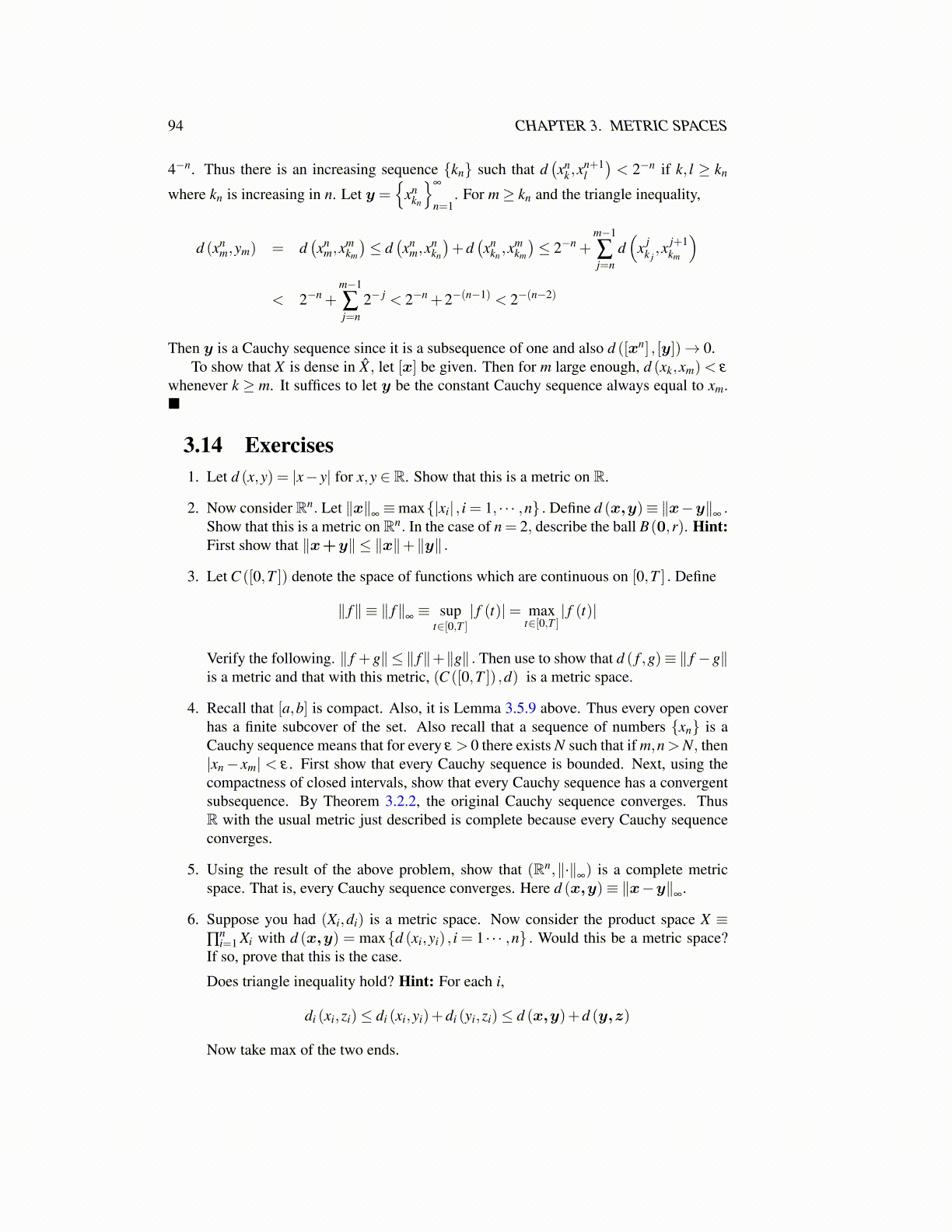
94 CHAPTER 3. METRIC SPACES
4−n. Thus there is an increasing sequence {kn} such that d(xn
k ,xn+1l
)< 2−n if k, l ≥ kn
where kn is increasing in n. Let y ={
xnkn
}∞
n=1. For m≥ kn and the triangle inequality,
d (xnm,ym) = d
(xn
m,xmkm
)≤ d
(xn
m,xnkn
)+d(xn
kn,xm
km
)≤ 2−n +
m−1
∑j=n
d(
x jk j,x j+1
km
)< 2−n +
m−1
∑j=n
2− j < 2−n +2−(n−1) < 2−(n−2)
Then y is a Cauchy sequence since it is a subsequence of one and also d ([xn] , [y])→ 0.To show that X is dense in X̂ , let [x] be given. Then for m large enough, d (xk,xm)< ε
whenever k ≥ m. It suffices to let y be the constant Cauchy sequence always equal to xm.■
3.14 Exercises1. Let d (x,y) = |x− y| for x,y ∈ R. Show that this is a metric on R.
2. Now consider Rn. Let ∥x∥∞≡max{|xi| , i = 1, · · · ,n} . Define d (x,y)≡ ∥x−y∥
∞.
Show that this is a metric on Rn. In the case of n = 2, describe the ball B(0,r). Hint:First show that ∥x+y∥ ≤ ∥x∥+∥y∥ .
3. Let C ([0,T ]) denote the space of functions which are continuous on [0,T ] . Define
∥ f∥ ≡ ∥ f∥∞≡ sup
t∈[0,T ]| f (t)|= max
t∈[0,T ]| f (t)|
Verify the following. ∥ f +g∥ ≤ ∥ f∥+∥g∥ . Then use to show that d ( f ,g)≡ ∥ f −g∥is a metric and that with this metric, (C ([0,T ]) ,d) is a metric space.
4. Recall that [a,b] is compact. Also, it is Lemma 3.5.9 above. Thus every open coverhas a finite subcover of the set. Also recall that a sequence of numbers {xn} is aCauchy sequence means that for every ε > 0 there exists N such that if m,n>N, then|xn− xm| < ε . First show that every Cauchy sequence is bounded. Next, using thecompactness of closed intervals, show that every Cauchy sequence has a convergentsubsequence. By Theorem 3.2.2, the original Cauchy sequence converges. ThusR with the usual metric just described is complete because every Cauchy sequenceconverges.
5. Using the result of the above problem, show that (Rn,∥·∥∞) is a complete metric
space. That is, every Cauchy sequence converges. Here d (x,y)≡ ∥x−y∥∞
.
6. Suppose you had (Xi,di) is a metric space. Now consider the product space X ≡∏
ni=1 Xi with d (x,y) = max{d (xi,yi) , i = 1 · · · ,n} . Would this be a metric space?
If so, prove that this is the case.
Does triangle inequality hold? Hint: For each i,
di (xi,zi)≤ di (xi,yi)+di (yi,zi)≤ d (x,y)+d (y,z)
Now take max of the two ends.